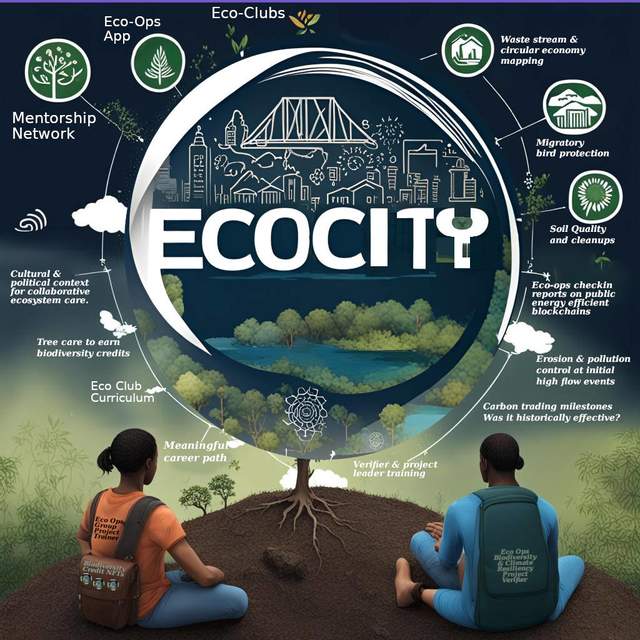Eco ops Checkin
Cross-Chain DAO Structure for NFT Management
Overview
This document outlines a novel approach to managing a core Ethereum-based NFT through a decentralized autonomous organization (DAO) that leverages NFTs on multiple blockchains. This structure enables cross-chain collaboration and governance, allowing different communities to share in the decision-making process regarding the core Ethereum NFT.
Core Concept
1. Core Ethereum NFT
- A single NFT is minted on the Ethereum blockchain, representing the central asset of the project. This NFT could symbolize ownership, access rights, or another key project element.
- Utility: This NFT might be used as collateral, unlock services, or act as a representation of ownership within a metaverse or another decentralized application.
2. Cross-Chain NFTs
- NFTs on other blockchains (e.g., XRP, ICP, Solana, BSC) are created to represent shares, votes, or other forms of management rights related to the core Ethereum NFT.
- Interoperability: These NFTs are linked or associated with the Ethereum NFT, allowing holders from different blockchains to participate in governance.
3. DAO Governance
- The Ethereum NFT is managed by a DAO, where decision-making power is distributed among cross-chain NFT holders.
- Voting Mechanism: Governance smart contracts on Ethereum would accept inputs from other chains, enabling cross-chain NFT holders to vote on proposals affecting the Ethereum NFT.
Technical Implementation
1. Interoperability
- Bridges: Protocols like Wormhole (for Solana) or Anyswap (for multiple chains) can facilitate cross-chain communication.
- Cross-Chain Messaging: Solutions like Chainlink CCIP or LayerZero allow for secure cross-chain messaging and governance.
2. Smart Contracts
- Ethereum Smart Contracts: Manage the core NFT, accepting commands and votes from linked cross-chain NFTs.
- Cross-Chain NFTs: Smart contracts on other blockchains mint and manage NFTs that connect back to the core Ethereum NFT’s DAO.
3. DAO Tools
- Platforms like Aragon, DAOstack, or Snapshot can be used to set up and manage the DAO.
- Voting & Proposals: Cross-chain NFT holders can propose and vote on how the core Ethereum NFT is used or managed.
Considerations
1. Security
- Risks: Bridges and cross-chain protocols are often targets for exploits, so security should be a priority.
- Audits: Regular audits of smart contracts are recommended to mitigate risks.
2. Complexity
- Management: Running a cross-chain DAO is more complex than a single-chain solution and requires careful planning.
- Interoperability: Ensuring smooth interaction between different blockchains is key to the success of this structure.
3. Gas Fees
- Ethereum Gas Fees: High transaction fees on Ethereum can be a limiting factor. Consider using Layer 2 solutions like Arbitrum or Optimism to reduce costs.
Conclusion
This cross-chain DAO structure offers a powerful way to manage a core Ethereum NFT collaboratively, leveraging the strengths of multiple blockchains. By distributing governance across different NFT communities, this model promotes decentralized decision-making and can be tailored to various project needs, from art and collectibles to metaverse assets.
Resources:
This document is part of our ongoing exploration of decentralized technologies and their applications in sustainable community development.
The ‘Eco Ops app’ uses the following data formats for compiling project data. We are currently testing with data written to ipfs via nft.storage 24 Dec 2024 Please check out https://ecocity.com/kath4b to use the current data input tool.
| Prop | Description | Input URL | Fields | Example Metadata File |
| garbageMap | garbage related resource map item | Number | location, time, mapper, group, project, photo(s), video(s), url, info url | https://gist.github.com/biomassives/a4945e0a49b2695b861c85dae38834bc
| wqMap | water quality related resource map item | Number | location, time, mapper, group, project, photo(s), video(s), url, info url | https://gist.github.com/biomassives/8846460606990f13c3b7b64d26c4b3bf
| farmMap | farm practice set as a goal for climate credit | Array | activity, milestone, compensation method, location, time, time duration, mapper, group, project, photo(s), video(s), url, info url | https://gist.github.com/biomassives/bc14a8bb06bb01019dc6270cdfb6d207
| productMap | the resource being produced making use of circular | String | activity, location, time, retail value of item, number of items, project, photo(s), video(s), url, info url | https://gist.github.com/biomassives/d5c6b54a34b26ad58b6cf40b510ffe43
| transportMap | the resource being moved from point a to b | String | activity, driver pay, payment receipt, receiving location, source location, departure time, arrval time, group, project, photo(s), video(s), url, info url | https://gist.github.com/biomassives/7b40ac77101e07c24202b4edd74b3942
| storageMap | the resource stored, and placed in specific location | String | activity, driver pay, payment receipt, receiving location, source location, departure time, arrval time, group, project, photo(s), video(s), url, info url | https://gist.github.com/biomassives/ce7773d941951dd22fcae981cc394bcd
| sourceMap | source of items of interest in project | String | item name, item provider, material cost, unit of measure, payment receipt, recieving location, source location, group, project, photo(s), video(s), url, info url | https://gist.github.com/biomassives/a56d1df413a219833383654ecb8ddb2b
| cleaningMap | the human contact with items of interest in project | String | activity, service provider, cleaning pay, payment receipt, receiving location, source location, departure time, arrval time, group, project, photo(s), video(s), url, info url | https://gist.github.com/biomassives/a27b818ba8a4ab37076ac8425dc5fdf4
